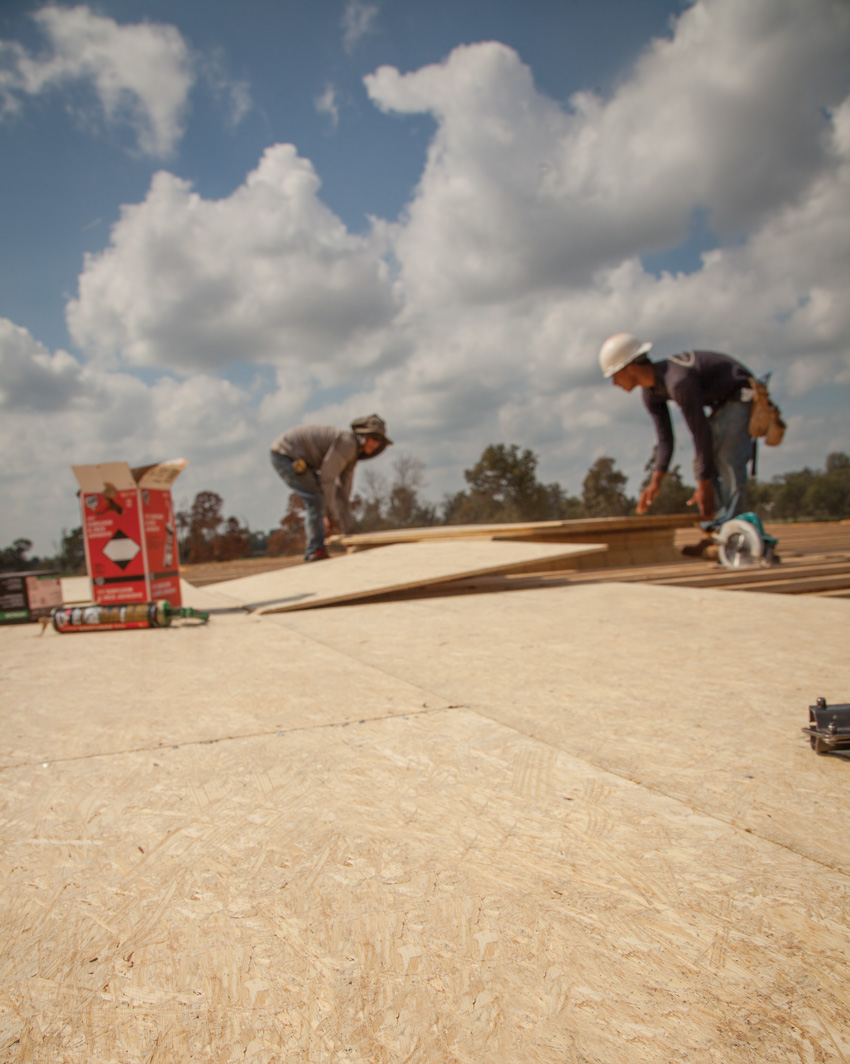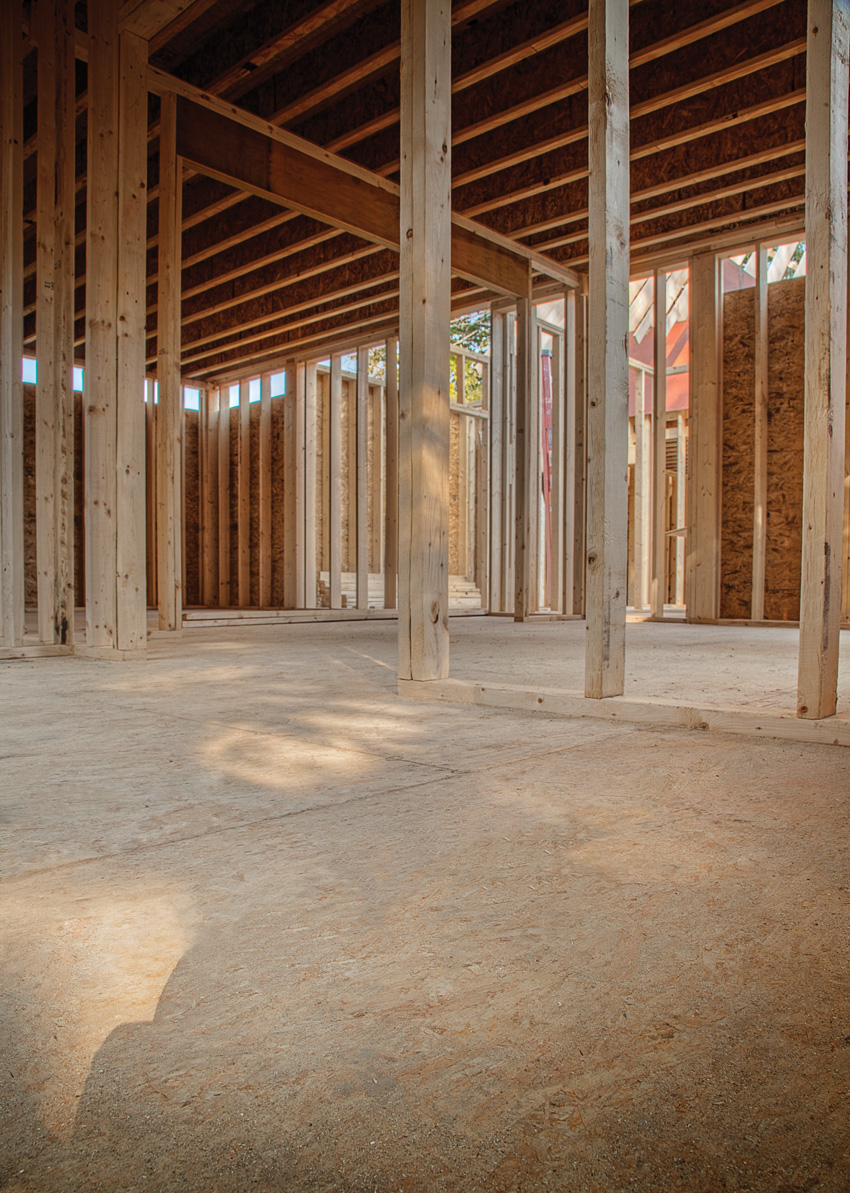Overcoming Structural Floor Squeaks in Wood-Framed Construction
Finished Flooring
By now it should be clear that attention to the framing and subfloor construction details can mean the difference between quality construction and floors that are compromised and prone to squeaks and other defects. Only after these structural components are properly addressed does it then make sense to look at the finish flooring. As noted earlier, most of the issues that show up in the finish flooring after a building is occupied is usually the result of problems with the subfloor system. This can be true if the subfloor is uneven or unstable to begin with, and can also become true if the materials are damaged during construction or if the bond between the subfloor panels and the framing members isn’t complete. Hence, it is critical to address all of the issues we have talked about thus far before considering any expenditure on the finish flooring to be sure that the finish flooring can also be installed properly to mitigate risks of squeaks.

Finished flooring in the form of carpeting, wood flooring, or tile can all be accommodated successfully and securely with high-performance subfloor panels.
All of that said, there are some things to consider about the finish flooring itself to be sure that the project is completed properly and squeaks or other defects are avoided. The first is to be sure that the finish flooring and the subfloor system are designed and installed to work together. If they are nailed or secured together and one deflects or bends differently than the other, differential movement can occur between them as evidenced by telltale floor squeaks. In the case of wood flooring, that means proper nailing and proper installation following established guidelines and recommendations. For laminated or engineered wood products, the manufacturer’s recommendations and installation directions need to be adhered to. Most natural wood-plank flooring will have cleats or staples holding and securing the flooring to the subfloor. If the subfloor deflects too much or does not have the ability to hold on to the cleats or staples under foot traffic, then squeaks and pops can occur. In order to avoid this source of floor noise, it is important that the subfloor be both stiff and high in fastener holding power. For ceramic or porcelain tile flooring, underlayments can be adhered, fastened, or, in some cases, float on top of the subfloor. For the fastened systems, it is important for the subfloor be able to grab the fastener and not let go. However, no matter what underlayment is used, it is always important that the subfloor be stiff and not have excessive deflection. When a subfloor sags too much, cracks can occur.
It is prudent to keep in mind the finish flooring when selecting subfloor panels since some are better suited to success than others for different flooring types. OSB is fine for carpets but can be prone to nail pops if a strong, high-performance engineered wood panel is not specified. Further, traditional OSB may not work as well for some hardwood flooring if it has become uneven from swelling during exposure during construction. Plywood may provide adequate strength, but it still requires diligence to avoid problems with edges and seams if delamination occurs from moisture during construction. High-performance engineered wood panels have been used successfully on all finish flooring types, which is particularly useful if the final selections are uncertain or subject to change.
Conclusion
Architects, builders, contractors, and remodelers who have experienced the pain of job delays, callbacks, or professional liability for squeaky subfloors can now work to avoid those problems. The combination of appropriately selected floor framing and high-performance engineered wood subfloor panels held together with deformed fasteners and polyurethane spray-foam subfloor adhesive can meet high-quality expectations for a solid, quiet flooring base. Further, the subfloor system can help reduce squeaks, bounce, or uneven finished flooring results by being designed with materials providing powerful moisture resistance, strength, and stiffness characteristics that help subfloor panels stay flat with no sanding required, even after exposure to harsh job-site conditions. In the end, the result is a quality project that will hold up over time and provide the intended satisfaction to the owners and users.
Foot Notes
1 Clark, Bob. “Top 10 Framing Errors and How to Avoid Them.” Professional Builder. 18 February 2012. Web. September 2016. http://www.probuilder.com/top-10-framing-errors-and-how-prevent-them.
2 Henkenius, Merle. “Fixing a Squeaky Floor.” This Old House. Web. September 2016. https://www.thisoldhouse.com/how-to/fixing-squeaky-floor.
3 See ESR-1785, an Evaluation Service Report by the International Code Council’s Evaluation Services, for the only structural panel with documented design values for strength, stiffness, and fastener holding power above code standards (PS-2).
4 When tested in accordance to ASTM D3498 standards, one spray-foam, gun-applied subfloor adhesive shows a bond that is two to five times stronger than the code minimum under various conditions.
5 Based on one spray-foam subfloor adhesive manufacturer’s testing: One can of the cited subfloor spray-foam subfloor adhesive yields approximately 400 linear feet of at a 1/2-inch diameter bead. When compared to a 28-ounce caulk cartridge of typical subfloor adhesive, applied at a 3/8-inch bead per the manufacturer’s instructions, the spray foam yields approximately eight times the coverage than that of the conventional adhesive. That means it would take eight cartridges of conventional adhesive to cover the same construction area as one container of this spray-foam adhesive.
6 See the International Residential Code (IRC), published by the International Code Council, Inc. (ICC).
Peter J. Arsenault, FAIA, NCARB, LEED AP, is a practicing architect, green building consultant, continuing education presenter, and prolific author engaged nationwide in advancing building performance through better design. www.linkedin.com/in/pjaarch

|
Get the FLAT OUT BEST start to a quiet, stiff floor with an AdvanTech Subfloor Assembly that combines the moisture resistance and strength of AdvanTech panels with the polyurethane bond of NEW AdvanTech subfloor adhesive. It’s a panel-to-joist connection so strong, you won’t hear a squeak – guaranteed. Find out how to get the Squeak-Free Guarantee on your next residential job to avoid squeaky, bouncy floor callbacks at AdvanTechQuiet.com. Limitations and restrictions apply, visit SqueakFreeGuarantee.com for material specifications. |










